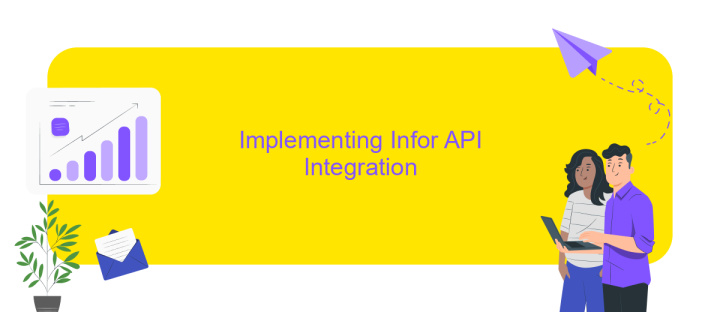Infor API Integration
Infor API Integration is a crucial component for businesses looking to enhance their operational efficiency and data management. By seamlessly connecting Infor's robust suite of enterprise applications with various third-party systems, companies can streamline processes, reduce manual errors, and achieve real-time data synchronization. This integration empowers organizations to make informed decisions, improve productivity, and maintain a competitive edge in today's fast-paced digital landscape.
Understanding Infor APIs and Integration Methods
Infor APIs are essential tools that enable seamless integration between Infor applications and other systems. They provide a standardized way for different software components to communicate, ensuring data consistency and operational efficiency. Understanding these APIs is crucial for businesses aiming to optimize their workflows and leverage the full potential of their Infor solutions.
- RESTful APIs: These APIs use HTTP requests to access and manipulate data, offering a flexible and scalable integration method.
- SOAP APIs: Based on standard protocols, SOAP APIs provide robust security features, making them ideal for enterprise-level integrations.
- OData APIs: These APIs facilitate data exchange by using a standardized protocol, simplifying data sharing between disparate systems.
Choosing the right integration method depends on several factors, including the specific requirements of the business, the complexity of the systems involved, and the desired level of security. By leveraging Infor APIs, companies can achieve more efficient data management, reduce manual intervention, and foster innovation through enhanced connectivity. Understanding these integration methods is a step towards unlocking the full capabilities of Infor's technological ecosystem.
Planning Your Infor API Integration Project

Embarking on an Infor API integration project requires meticulous planning to ensure seamless connectivity and functionality. Begin by clearly defining your integration objectives, identifying which Infor applications and data points need to be connected. Consider the specific business processes that will benefit from this integration and establish measurable goals. It's crucial to involve all relevant stakeholders early in the process to gather comprehensive requirements and ensure alignment with organizational needs. Additionally, assess the technical environment, including existing systems and potential compatibility issues, to identify any challenges that may arise during the integration process.
Once the objectives and requirements are clear, explore integration solutions that can streamline the process. Tools like ApiX-Drive can be instrumental in simplifying the integration setup by providing pre-built connectors and a user-friendly interface. Such services can significantly reduce development time and effort, allowing your team to focus on more strategic tasks. Establish a timeline with milestones to track progress and allocate resources effectively. Regular testing and validation throughout the project will ensure that the integration meets your expectations and operates smoothly upon completion. By taking these steps, you can achieve a successful Infor API integration that enhances your business operations.
Implementing Infor API Integration

Integrating Infor APIs into your existing systems can significantly enhance your business operations, offering seamless data exchange and improved functionality. The process involves several key steps, each crucial for ensuring a successful integration. By following a structured approach, you can leverage Infor's capabilities to their fullest potential.
- Begin by identifying the specific APIs offered by Infor that align with your business requirements. This involves understanding the functionalities and data these APIs provide.
- Set up a secure environment for API testing. This includes configuring authentication protocols and ensuring data security measures are in place.
- Develop the integration logic, which involves writing the necessary code to connect your systems with Infor APIs. Use appropriate programming languages and frameworks that support API interactions.
- Conduct thorough testing to ensure that the integration works as expected. This includes validating data flows, error handling, and performance benchmarks.
- Deploy the integration to your production environment, ensuring minimal disruption to existing processes.
After implementation, continuous monitoring and maintenance are essential to address any issues that may arise. Regular updates and optimizations can further enhance the integration, ensuring it continues to meet evolving business needs and technological advancements.
Testing and Deploying Your Integration

Once your Infor API integration is developed, the next critical step is to thoroughly test it to ensure seamless functionality and reliability. Testing allows you to identify and rectify any issues, ensuring that the integration meets all business requirements and operates smoothly within your existing systems. It is essential to simulate real-world scenarios to validate the integration's performance under different conditions.
Begin by conducting unit tests to verify individual components, followed by integration tests to assess the interaction between integrated systems. Ensure that all data is correctly exchanged and processed. It's also crucial to test the integration's security features to protect sensitive information from unauthorized access.
- Perform unit and integration testing.
- Validate data exchange and processing.
- Test security protocols and data protection measures.
- Simulate real-world scenarios for performance testing.
After successful testing, proceed to deploy the integration in a controlled environment. Monitor the deployment closely to address any unexpected issues promptly. Ensure that all stakeholders are informed and prepared for the changes. A smooth deployment process will minimize disruptions and ensure that your Infor API integration delivers the desired benefits efficiently.
- Automate the work of an online store or landing
- Empower through integration
- Don't spend money on programmers and integrators
- Save time by automating routine tasks
Maintaining and Optimizing Your Infor API Integration
Ensuring the longevity and efficiency of your Infor API integration requires regular maintenance and optimization. Start by monitoring API performance through metrics such as response times and error rates. This helps in identifying bottlenecks and potential issues early. Regularly update your API documentation to reflect any changes in endpoints or data structures, ensuring seamless communication between systems. Implement automated testing to routinely check the functionality and reliability of your integration, catching issues before they impact operations.
Optimization involves not only refining the API calls but also enhancing data processing and storage. Consider using platforms like ApiX-Drive to streamline integration processes; its user-friendly interface and automation capabilities can significantly reduce manual workload, allowing your team to focus on strategic tasks. Regularly review and refine your data handling methods to ensure they meet current business needs and scalability requirements. By staying proactive with maintenance and optimization, you can ensure your Infor API integration continues to support your business effectively.
FAQ
What is Infor API Integration and why is it important?
How can I get started with Infor API Integration?
What are the common challenges faced during Infor API Integration?
How can I automate workflows using Infor API Integration?
What tools can assist with Infor API Integration?
Apix-Drive will help optimize business processes, save you from a lot of routine tasks and unnecessary costs for automation, attracting additional specialists. Try setting up a free test connection with ApiX-Drive and see for yourself. Now you have to think about where to invest the freed time and money!


